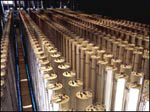 Bloomberg: During the next six months, the U.S. and its negotiating partners will try, in the words of President Barack Obama, to persuade Iran to agree on a “peaceful nuclear program,” including a “modest enrichment capability,” that leaves it short of the ability to produce nuclear weapons.
Bloomberg: During the next six months, the U.S. and its negotiating partners will try, in the words of President Barack Obama, to persuade Iran to agree on a “peaceful nuclear program,” including a “modest enrichment capability,” that leaves it short of the ability to produce nuclear weapons.
Bloomberg
By Gary Milhollin and Valerie Lincy

The continuing nuclear talks with Iran have just entered their most challenging phase. During the next six months, the U.S. and its negotiating partners will try, in the words of President Barack Obama, to persuade Iran to agree on a “peaceful nuclear program,” including a “modest enrichment capability,” that leaves it short of the ability to produce nuclear weapons.
This task will be far harder to achieve than is generally understood.
A civilian program to enrich uranium for nuclear power must, by its nature, be many times larger than a bomb program. That is the opposite of what most people think. In fact, a small-scale enrichment program for nuclear power doesn’t really exist. To understand why, let’s look at some numbers.
Everyone is worried about Iran’s centrifuges, the fast-spinning cylinders that enrich uranium. The cylinders can be used to make fuel for either power reactors or bombs. For comparison, it takes 25 times more enrichment power to fuel a standard-size, 1,000-megawatt reactor such as the one the Russians built in Bushehr, Iran, than it does to fuel a single bomb. Put another way, if Iran had the enrichment power to fuel the Bushehr reactor for a year and instead decided to make bombs, it could produce the fuel for a nuclear warhead every 15 days — 25 a year.
No deal with the U.S. would allow Iran to have such power. Moreover, such capability would be a vast scale-up of Iran’s current program. Iran now produces about 1.9 metric tons of enriched uranium a year. It takes approximately 20 metric tons to fuel a 1,000-megawatt reactor. To fuel a smaller, 360-megawatt reactor (which Iran says it will build), Iran would have to produce three times as much enriched uranium as it does now. Either option would allow Iran to fuel several nuclear weapons a year, if it chose to do so.
If Iran can’t be permitted to make the fuel for a power reactor, what good are its centrifuges? Their only possible use would be to fuel a nonpower reactor, such as the small research reactor in Tehran. However, Iran has already enriched more uranium than the Tehran reactor needs for the foreseeable future.
Iran’s centrifuges don’t fit into a peaceful nuclear power program. There are far too few to fuel a power reactor but quite enough for nuclear weapon production. This unfortunate fact hangs over the negotiations. So far, Iran’s centrifuges have enriched a stockpile of uranium that is two-thirds of the way to weapons-grade. By enriching its stockpile further, the Iranians could fuel about six nuclear weapons.
How will these numbers affect the talks? Is it possible for Iran to have a “modest enrichment capability” that can’t fuel a weapon?
One solution would be for Iran to keep running its centrifuges and get rid of its stockpile of enriched uranium. In this scenario, Iran’s centrifuges could be fed by natural uranium only. Starting at that level would require more power and time to produce weapons-grade fuel. If using natural uranium, the centrifuges Iran currently operates would need more than six months to enrich enough uranium for a bomb. That would give other countries time to intervene if Iran tried to make a dash for the bomb. The enriched uranium Iran has already produced could be sent to Russia, where it could be fashioned into fuel rods not readily convertible to weaponry. And Iran would have to leave approximately 9,000 of its centrifuges — about half — installed but nonoperational.
Another option would be for Iran to keep its enriched uranium but further scale back the operation of its centrifuges. This would be necessary because, theoretically, the roughly 9,000 operating centrifuges Iran currently has, if fed enriched uranium, would need only about two months to enrich enough uranium for a bomb. Because Iran has never enriched uranium to weapons-grade, the real timeline would be longer, but it is difficult to know how much. To theoretically extend the enrichment time to six months, Iran could operate no more than 3,000 centrifuges, leaving some 15,000 dormant.
For either option to work, Iran would have to allow inspectors unfettered access to its nuclear program, to guard against cheating. It also would have to dismantle or modify the large, plutonium-producing research reactor it is building in Arak, relinquish and stop expanding its small stockpile of uranium enriched to 20 percent, and agree to not operate additional centrifuges.
Will the Iranians agree? So far, the odds seem long. Iran has trumpeted its plans to expand, not contract, its supply of centrifuges. Nevertheless, the U.S. must insist upon one of these options. Otherwise, Iran will be left with centrifuges that contribute nothing to civilian nuclear energy but provide a clear path to the bomb.
(Gary Milhollin is president of the Wisconsin Project on Nuclear Arms Control, which publishes IranWatch.org; Valerie Lincy is executive director of the Wisconsin Project.)


